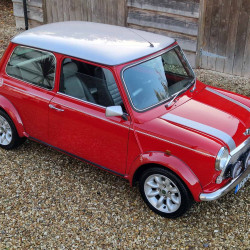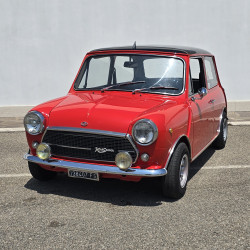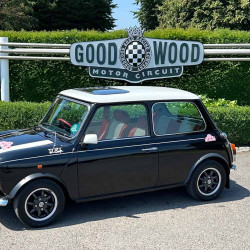GBP 32,995.00 / ≈ USD 43,458.31
Contact Information
Phone: +44 1684210915
E-Mail: sales@cultclassics.uk
Address: Open In New Tab
Summary
Location: United Kingdom / Glocestershire
Year Of Manufacture: 1971
Mileage: 3246 mil / 5224 km
SPECIFICATIONS
- Year Of Manufacture: 1971
- Mileage: 3246 mil / 5224 km
- Car Type: Saloon
- Drive: N/A
- Condition: Used
- Interior Colour: Black
- Number Of Doors: 2
- Number Of Seats: 4
- Location: United Kingdom / Glocestershire
- Exterior Colour: Red
- Gearbox: N/A
- Performance: 93 PS
- Drivetrain: N/A
- Fuel Type: N/A
DESCRIPTION
We are very excited to present for sale, this wonderful 1971 MK3 Mini Cooper S.
With just over 1500 examples rolling out of Longbridge, any Mk3 Cooper S survivor is now rare and highly prized, this particular example however is quite unique.
The History
Unlike nearly all MK3 Coopers, this one wasn’t finished at Longbridge. Instead, it was hand built from a genuine Cooper S shell by a chap called Denes Morvay, who worked for BMC/BL in fuel research at Cowley and was an acquaintance of Sir Alec Issigonis before the great man was transferred to Birmingham.
This car is the first of five Cooper S's that Mr Morvay built and is believed to be the only survivor. He’s thought to have been unhappy with the quality control at BL at the time, so he simply took the parts away and built the car himself. The shell was pulled from the line before it was given the usual XAD prefix chassis number, so it was registered using its body number instead, which is prefixed B20D and therefore correct for a Mk3 S. This remains listed as the car’s chassis number, and it still retains its original Oxfordshire registration plate too, which was issued on May 18, 1971 – around a month before Cooper S production ceased.
The Mini has had 8 owners and it is thanks to its last one, classic Lotus racer, Mr Malcolm Johnson, that we know so much about the history of this amazing little car. Thanks to his and the Mini Cooper register’s detective work, he was able to track down Denes Morvay, who incidentally now lives just down the road from us, and wrote to him.
Mr Morvay was delighted to hear that the car had survived. “I cannot believe it has had 8 owners and is still going strong, it must be my expertise,” he wrote in his response, and also supplied pictures of two of his other builds.
The car has since gone on to be shown at many Mini Cooper register shows and was featured in Mini Magazine last year.
The Mechanicals
We’re sure it hasn’t escaped your notice that this Cooper S is quite modified. The majority of the work can be attributed to its 6th owner, a Mr Ellis. During his tenure the engine was rebuilt by Southam Mini Metro Centre.
The rebuild centred around a nitrided EN40B crank from an earlier car that was reground and balanced. Liners were fitted to the block, before it was rebored by +0.020 to give 1293cc and fitted with new pistons. New bearings were also fitted, along with a Swiftune SW5 billet camshaft combined with vernier Duplex timing gear. On top, the cylinder head was prepared to fast road/track day spec, with 35.7mm inlet and 31mm exhaust valves. Meanwhile, the gearbox was completely rebuilt with new baulk rings and a crosspin differential.
Other later additions include a Maniflow centre exit exhaust, adjustable dampers plus new rubber springs up front with Hi-Lo trumpets.
All of the engine mods resulted in 93 BHP at the wheels, backed up by a rolling road print out and trust us, this is a very rapid little Mini!
The Exterior
The Cooper S looks resplendent in its Tartan red with Old English White roof colour scheme, this was the colour scheme of the original works rally Minis and is in fantastic condition.
The body was restored in 2014 by “The Z Farm” in Yorkshire, a company better known for their work on Datsun 240Zs. It’s testament to the quality of their work that the Mini remains in great shape today with no signs of rust or corrosion and a mile deep gloss to the paintwork.
The 4 period SEV Marshal 8” driving lamps, Lucas reversing lamp on the bootlid, period 5x10” Carmona Minilite style wheels and period correct Group 2 style arch extensions finish of the Works look perfectly.
The Interior
Inside, the car is period Mk3 Cooper S save for the 1275 GT door cards and optional reclining front seats.
There are also switches for the driving and reversing lamps, a race tech rev counter and Mountney steering wheel, all of which give the interior a proper period competition feel.
It is all in lovely condition as well with no real signs of wear and tear.
The Paperwork
The car comes with a huge folder of paperwork including the letter from Mr Morvay and photos of 2 of his other hand built Minis, lots of correspondence from the Mini Cooper register and Mr Johnson detailing their quest to track down the Mini’s history, Full details of the engine rebuild including rolling road graphs, a list of all the previous owners, loads of invoices for various service items and of course its current V5.
The Conclusion
So, summing up, this is a superb example of a Mk3 Cooper S that has been professionally restored and tastefully modified in a period perfect style. Add to that its fascinating history and you have a very special little car indeed. It just requires someone to add another chapter to the intriguing story of this unique Mk3 S.
With just over 1500 examples rolling out of Longbridge, any Mk3 Cooper S survivor is now rare and highly prized, this particular example however is quite unique.
The History
Unlike nearly all MK3 Coopers, this one wasn’t finished at Longbridge. Instead, it was hand built from a genuine Cooper S shell by a chap called Denes Morvay, who worked for BMC/BL in fuel research at Cowley and was an acquaintance of Sir Alec Issigonis before the great man was transferred to Birmingham.
This car is the first of five Cooper S's that Mr Morvay built and is believed to be the only survivor. He’s thought to have been unhappy with the quality control at BL at the time, so he simply took the parts away and built the car himself. The shell was pulled from the line before it was given the usual XAD prefix chassis number, so it was registered using its body number instead, which is prefixed B20D and therefore correct for a Mk3 S. This remains listed as the car’s chassis number, and it still retains its original Oxfordshire registration plate too, which was issued on May 18, 1971 – around a month before Cooper S production ceased.
The Mini has had 8 owners and it is thanks to its last one, classic Lotus racer, Mr Malcolm Johnson, that we know so much about the history of this amazing little car. Thanks to his and the Mini Cooper register’s detective work, he was able to track down Denes Morvay, who incidentally now lives just down the road from us, and wrote to him.
Mr Morvay was delighted to hear that the car had survived. “I cannot believe it has had 8 owners and is still going strong, it must be my expertise,” he wrote in his response, and also supplied pictures of two of his other builds.
The car has since gone on to be shown at many Mini Cooper register shows and was featured in Mini Magazine last year.
The Mechanicals
We’re sure it hasn’t escaped your notice that this Cooper S is quite modified. The majority of the work can be attributed to its 6th owner, a Mr Ellis. During his tenure the engine was rebuilt by Southam Mini Metro Centre.
The rebuild centred around a nitrided EN40B crank from an earlier car that was reground and balanced. Liners were fitted to the block, before it was rebored by +0.020 to give 1293cc and fitted with new pistons. New bearings were also fitted, along with a Swiftune SW5 billet camshaft combined with vernier Duplex timing gear. On top, the cylinder head was prepared to fast road/track day spec, with 35.7mm inlet and 31mm exhaust valves. Meanwhile, the gearbox was completely rebuilt with new baulk rings and a crosspin differential.
Other later additions include a Maniflow centre exit exhaust, adjustable dampers plus new rubber springs up front with Hi-Lo trumpets.
All of the engine mods resulted in 93 BHP at the wheels, backed up by a rolling road print out and trust us, this is a very rapid little Mini!
The Exterior
The Cooper S looks resplendent in its Tartan red with Old English White roof colour scheme, this was the colour scheme of the original works rally Minis and is in fantastic condition.
The body was restored in 2014 by “The Z Farm” in Yorkshire, a company better known for their work on Datsun 240Zs. It’s testament to the quality of their work that the Mini remains in great shape today with no signs of rust or corrosion and a mile deep gloss to the paintwork.
The 4 period SEV Marshal 8” driving lamps, Lucas reversing lamp on the bootlid, period 5x10” Carmona Minilite style wheels and period correct Group 2 style arch extensions finish of the Works look perfectly.
The Interior
Inside, the car is period Mk3 Cooper S save for the 1275 GT door cards and optional reclining front seats.
There are also switches for the driving and reversing lamps, a race tech rev counter and Mountney steering wheel, all of which give the interior a proper period competition feel.
It is all in lovely condition as well with no real signs of wear and tear.
The Paperwork
The car comes with a huge folder of paperwork including the letter from Mr Morvay and photos of 2 of his other hand built Minis, lots of correspondence from the Mini Cooper register and Mr Johnson detailing their quest to track down the Mini’s history, Full details of the engine rebuild including rolling road graphs, a list of all the previous owners, loads of invoices for various service items and of course its current V5.
The Conclusion
So, summing up, this is a superb example of a Mk3 Cooper S that has been professionally restored and tastefully modified in a period perfect style. Add to that its fascinating history and you have a very special little car indeed. It just requires someone to add another chapter to the intriguing story of this unique Mk3 S.





